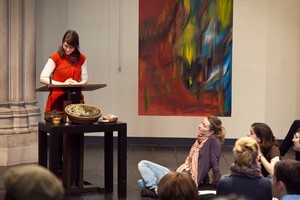In Transition: To spend even a bit of time in conversation with Union Theological Seminary graduate, recent Stony Point Fellow, and artist Emily Otto is to be invited into an unfolding calling that is as rich as the colors of the paint she makes from the ground’s clay.“What the church is doing with 1001 is so exciting to me,” shared Otto, in an interview by phone. “It’s wonderful that the church, rather than trying to plug up holes, is actually thinking of building a whole new ship.”
“I think that 1001 is such an innovative way of thinking outside the box, outside the church as steeple and sanctuary—how to meet our culture in venues that are more authentic for them,” shared Otto. The venue that Otto, an artist, finds herself drawn to is the community surrounding the arts. Otto was brought to Stony Point to be the first of what hopes to be an ongoing Artist in Residence program and to help cultivate an artistic community at the center. “I found that, within that context and others, there is such a performative aspect to art that people have a tendency to shy away from,” said Otto. The issue seems to Otto to be a tendency to focus on the product or result and lose sight of the process that leads one to that result.
“For me, personally, it is the ‘flow’ part that bears the fruit with art—to get into that artistic flow is a way of accessing communication with the divine,” she shared. The year spent at Stony Point only served to confirm her sense of her own calling, as well as what she had learned in her work with artists communities during her undergraduate years at Mt. Holyoke. While an undergraduate, Otto became involved with the arts on campus by running the art gallery and the student art board (a group of students who create art as well as those who are art enthusiasts). “Since the group had been dwindling, I was trying to reenvision how to make it exciting and how to structure our meetings,” shared Otto. “I realized that there needed to be a sort of ‘joys and concerns’ moment and then thought to myself, ‘Wait, what am I doing here?’ ” What struck her was that, in her work with the student art board, she was actually trying to build a church.
This natural development of the artistic process was something Otto also experienced working at Ghost Ranch during her summer seminary break from Union. During her time at Ghost Ranch she learned from a local artist how to make her own paint out of the clay and rock in the area. It was the summer before she started her master’s thesis, and Otto had some sense that she wanted to explore the anointing of Jesus by the unnamed woman in Mark. She collected clay and rocks at Ghost Ranch and had them shipped back to New York City. “The process turned out to be a very meditative one—crushing and smashing these materials with oil,” remembered Otto. She got to the point where she had to decide what type of oil to buy to mix with the colors—an inexpensive linseed or a much more expensive walnut oil. It was there that the passage from Mark and her artistic expression intersected. “I could just hear the disciples grumbling at the cost,” Otto remembered.
So she decided to use nard as the oil for her paints.
“The process was so fruitful for me personally,” said Otto, who created three large paintings out of that mixture, all three meditations on the text, and displayed them in the seminary chapel as part of a Lenten worship service that she lead. In reflecting on these various experiences—cultivating an appreciation for process and a community centered around the arts—and what that might look like in the context of a new worshiping community, Otto is confident about one thing: it begins in relationship, talking with people, and listening for the areas that resonate. “I am really drawn to creating a safe space for a community to develop in its own natural way,” continued Otto. “My work there has been being playful and trying to loosen up some boundaries of what art is—it can be ritual, play, gardening, compost—and is not so much about producing an object but seeing your environment, getting in touch with your intuition, and being in community.”
It is a process that continues to bear fruit in her life of faith and ministry. “I would love to engage with other artists and nonartists, with anyone who has a desire to engage with the earth in that way, and with art materials, and with the text—and see what kind of synchronistic things come out of that.” “I think there is so much value in not only playing with creation and creating but also playing with Scripture and in the context of community,” said Otto. It is that type of community that she hopes to foster.
It’s new space for her even as it is for the church. But it is a calling, a process, that she is following as it continues to unfold before her.

